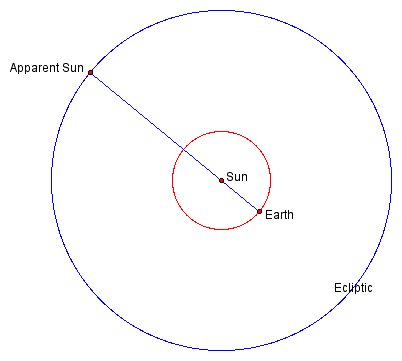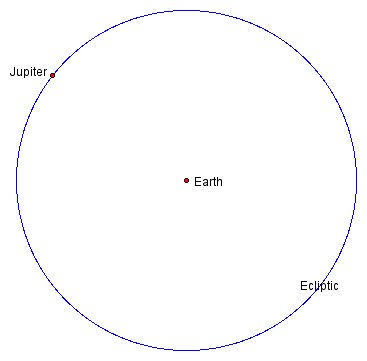- About MAA
- Membership
- MAA Publications
- Periodicals
- Blogs
- MAA Book Series
- MAA Press (an imprint of the AMS)
- MAA Notes
- MAA Reviews
- Mathematical Communication
- Information for Libraries
- Author Resources
- Advertise with MAA
- Meetings
- Competitions
- Programs
- Communities
- MAA Sections
- SIGMAA
- MAA Connect
- Students
- MAA Awards
- Awards Booklets
- Writing Awards
- Teaching Awards
- Service Awards
- Research Awards
- Lecture Awards
- Putnam Competition Individual and Team Winners
- D. E. Shaw Group AMC 8 Awards & Certificates
- Maryam Mirzakhani AMC 10 A Awards & Certificates
- Two Sigma AMC 10 B Awards & Certificates
- Jane Street AMC 12 A Awards & Certificates
- Akamai AMC 12 B Awards & Certificates
- High School Teachers
- News
You are here
Triangles in the Sky: Trigonometry and Early Theories of Planetary Motion - The Wandering Stars (continued)
A little thought will convince you that the apparent motion of the sun around the ecliptic is caused by the earth’s actual yearly revolution of the sun. The idea is illustrated in Figure 2. [To view the animation for this and the succeeding figures, click on "Figure x" below the illustration. You will then open a new window with an animated version of the Figure. You will need to have Java enabled on your computer.]

In Figure 2, the blue line is the line of sight from the earth to the sun, and the “apparent sun” is the apparent position of the sun within the far distant background of the stars. Animating the figure we see that as the earth revolves around the sun, the blue line of sight rotates around the earth, which causes the apparent sun to revolve around the blue circle (the ecliptic). Hence, as seen from earth, the sun appears to circle the earth around the ecliptic once a year.
The planets also appear to circle the earth around the ecliptic, each at its own rate, moving generally from west to east. The average time it takes for one complete cycle ranges from one year for Mercury and Venus to almost 30 years for Saturn. However, the motion of a planet along the ecliptic is far from uniform. This is illustrated by animating Figure 3, which simulates the 12-year journey of Jupiter around the ecliptic.

As Figure 3 illustrates, as a planet travels around the ecliptic, it periodically slows down, stops, and reverses its direction for a short time, moving from east to west instead of west to east. These so-called retrograde motions were observed and studied by the ancient Babylonians.
In order to quantify their observations of planetary motions, the Babylonians divided the ecliptic into 360°, with 0° taken to be the apparent location on the ecliptic of the sun at the spring equinox. The measure in degrees of a planet’s apparent position on the ecliptic is called its longitude. Using astronomical instruments, it was possible for early astronomers to measure a planet’s longitude and thereby track its motion around the ecliptic though time. A planetary model, as conceived of by the Greeks, is a geometric model that replicates this observed motion of the planet around the ecliptic. Such a model must agree with observational data and in particular must adequately account for the planet’s retrograde motions.
Sandra M. Caravella (New Jersey City University), "Triangles in the Sky: Trigonometry and Early Theories of Planetary Motion - The Wandering Stars (continued)," Convergence (August 2010), DOI:10.4169/loci003120




